Stewart J. Calculus
Подождите немного. Документ загружается.

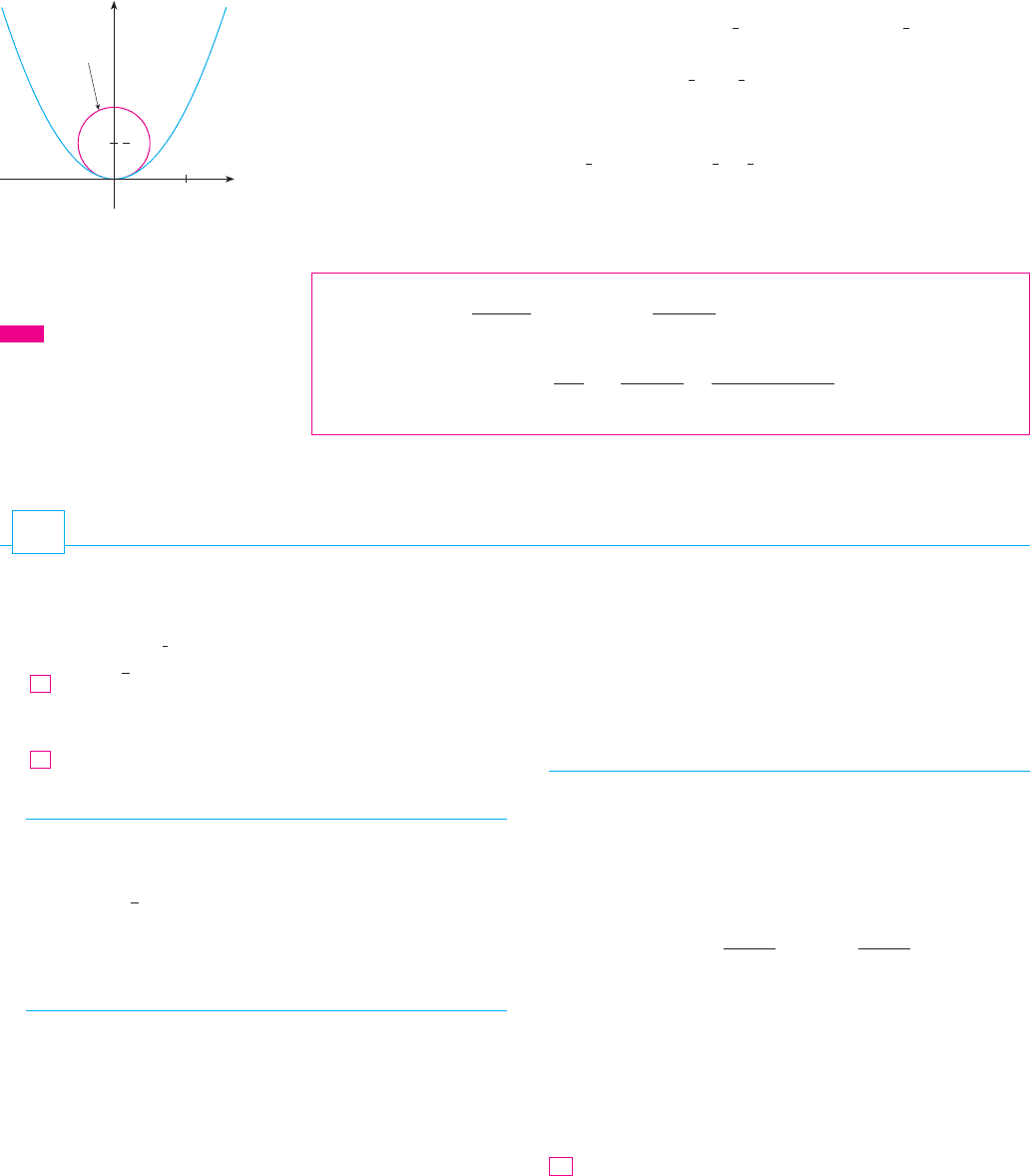
EXAMPLE 8 Find and graph the osculating circle of the parabola at the origin.
SOLUTION From Example 5 the curvature of the parabola at the origin is . So the
radius of the osculating circle at the origin is and its center is . Its equation
is therefore
For the graph in Figure 9 we use parametric equations of this circle:
M
We summarize here the formulas for unit tangent, unit normal and binormal vectors,
and curvature.
苷
冟
dT
ds
冟
苷
ⱍ
T共t兲
ⱍ
ⱍ
r共t兲
ⱍ
苷
ⱍ
r共t兲 r共t兲
ⱍ
ⱍ
r共t兲
ⱍ
3
B共t兲 苷 T共t兲 N共t兲N共t兲 苷
T共t兲
ⱍ
T共t兲
ⱍ
T共t兲 苷
r共t兲
ⱍ
r共t兲
ⱍ
y 苷
1
2
1
2
sin tx 苷
1
2
cos t
x
2
(
y
1
2
)
2
苷
1
4
(
0,
1
2
)
1兾
苷
1
2
共0兲 苷 2
y 苷 x
2
872
||||
CHAPTER 14 VECTOR FUNCTIONS
y
x
0
1
2
1
y=≈
osculating
circle
FIGURE 9
Visual 14.3C shows how the oscu-
lating circle changes as a point moves along
a curve.
TEC
12. Find, correct to four decimal places, the length of the curve
of intersection of the cylinder and the plane
.
13–14 Reparametrize the curve with respect to arc length mea-
sured from the point where in the direction of increasing .
13.
14.
15. Suppose you start at the point and move 5 units
along the curve , , in the positive
direction. Where are you now?
16. Reparametrize the curve
with respect to arc length measured from the point (1, 0) in
the direction of increasing . Express the reparametrization in
its simplest form. What can you conclude about the curve?
17–20
(a) Find the unit tangent and unit normal vectors and .
(b) Use Formula 9 to find the curvature.
r共t兲 苷 具2 sin t, 5t, 2 cos t 典
17.
N共t兲T共t兲
t
r共t兲 苷
冉
2
t
2
1
1
冊
i
2t
t
2
1
j
z 苷 3 cos ty 苷 4tx 苷 3 sin t
共0, 0, 3兲
r共t兲 苷 e
2t
cos 2t i 2 j e
2t
sin 2t k
r共t兲 苷 2t i 共1 3t兲 j 共5 4t兲 k
tt 苷 0
x y z 苷 2
4x
2
y
2
苷 4
1–6 Find the length of the curve.
1. ,
2. ,
,
4. ,
,
6. ,
7–9 Find the length of the curve correct to four decimal places.
(Use your calculator to approximate the integral.)
7. ,
8. ,
9. ,
;
10. Graph the curve with parametric equations ,
, . Find the total length of this curve
correct to four decimal places.
11. Let be the curve of intersection of the parabolic cylinder
and the surface . Find the exact length of
from the origin to the point .共6, 18, 36兲
C3z 苷 xyx
2
苷 2y
C
z 苷 sin 3ty 苷 sin 2t
x 苷 sin t
0 t
兾4r共t兲 苷 具sin t, cos t, tan t典
1 t 2r共t兲 苷 具t, ln t, t ln t典
1 t 4r共t兲 苷
具
s
t
, t, t
2
典
0 t 1r共t兲 苷 12t
i 8t
3兾2
j 3t
2
k
0 t 1r共t兲 苷
i t
2
j t
3
k
5.
0 t
兾4r共t兲 苷 cos t i sin t j ln cos t k
0 t 1
r共t兲 苷
s
2t
i e
t
j e
t
k
3.
0 t 1r共t兲 苷
具
2t, t
2
,
1
3
t
3
典
10 t 10r共t兲 苷 具2 sin t, 5t, 2 cos t典
EXERCISES
14.3

36–37 Two graphs, and , are shown. One is a curve
and the other is the graph of its curvature function .
Identify each curve and explain your choices.
36.
38. (a) Graph the curve . At how
many points on the curve does it appear that the curvature
has a local or absolute maximum?
(b) Use a CAS to find and graph the curvature function. Does
this graph confirm your conclusion from part (a)?
39. The graph of is shown in
Figure 12(b) in Section 14.1. Where do you think the curva-
ture is largest? Use a CAS to find and graph the curvature
function. For which values of is the curvature largest?
40. Use Theorem 10 to show that the curvature of a plane para-
metric curve , is
where the dots indicate derivatives with respect to .
41– 42 Use the formula in Exercise 40 to find the curvature.
41. ,
42. ,
43– 44 Find the vectors , , and at the given point.
,
44. ,
45– 46 Find equations of the normal plane and osculating plane
of the curve at the given point.
45. ,, ;
46. ,,;
;
47. Find equations of the osculating circles of the ellipse
at the points and . Use a graphing
calculator or computer to graph the ellipse and both oscu-
lating circles on the same screen.
共0, 3兲共2, 0兲9x
2
4y
2
苷 36
共1, 1, 1兲z 苷 t
3
y 苷 t
2
x 苷 t
共0,
, 2兲z 苷 2 cos 3ty 苷 tx 苷 2sin 3t
共1, 0, 0兲r共t兲 苷 具cos t, sin t, ln cos t典
(
1,
2
3
, 1
)
r共t兲 苷
具
t
2
,
2
3
t
3
, t
典
43.
BNT
y 苷 t t
2
x 苷 1 t
3
y 苷 e
t
sin tx 苷 e
t
cos t
t
苷
ⱍ
x y yx
ⱍ
关x
2
y
2
兴
3兾2
y 苷 t共t兲x 苷 f 共t兲
t
r共t兲 苷
具
t
3
2
sin t, 1
3
2
cos t, t
典
CAS
r共t兲 苷 具sin 3t, sin 2t, sin 3t 典
CAS
y
x
a
b
y
x
a
b
37.
y 苷
共x兲
y 苷 f 共x兲ba
18. ,
19.
20.
21– 23 Use Theorem 10 to find the curvature.
21.
22.
23.
24. Find the curvature of at the
point (1, 0, 0).
25. Find the curvature of at the point (1, 1, 1).
;
26. Graph the curve with parametric equations
and find the curvature at the point .
27–29 Use Formula 11 to find the curvature.
27. 28. 29.
30–31 At what point does the curve have maximum curvature?
What happens to the curvature as ?
30.
32. Find an equation of a parabola that has curvature 4 at the
origin.
(a) Is the curvature of the curve shown in the figure greater
at or at ? Explain.
(b) Estimate the curvature at and at by sketching the
osculating circles at those points.
;
34 –35 Use a graphing calculator or computer to graph both the
curve and its curvature function on the same screen. Is the
graph of what you would expect?
34. 35.
y 苷 x
2
y 苷 x
4
2x
2
共x兲
1
1
x
0
y
P
Q
C
QP
QP
C
33.
y 苷 e
x
31.
y 苷 ln x
x l
y 苷 4x
5兾2
y 苷 cos xy 苷 2x x
2
共1, 4, 1兲
z 苷 t
2
y 苷 4t
3兾2
x 苷 t
r共t兲 苷 具 t, t
2
, t
3
典
r共t兲 苷 具e
t
cos t, e
t
sin t, t典
r共t兲 苷 3t i 4 sin t j 4 cos t k
r共t兲 苷 t i t j 共1 t
2
兲 k
r共t兲 苷 t
2
i t k
r共t兲 苷
具
t,
1
2
t
2
, t
2
典
r共t兲 苷
具
s
2
t, e
t
, e
t
典
t 0r共t兲 苷 具t
2
, sin t t cos t, cos t t sin t典
SECTION 14.3 ARC LENGTH AND CURVATURE
||||
873
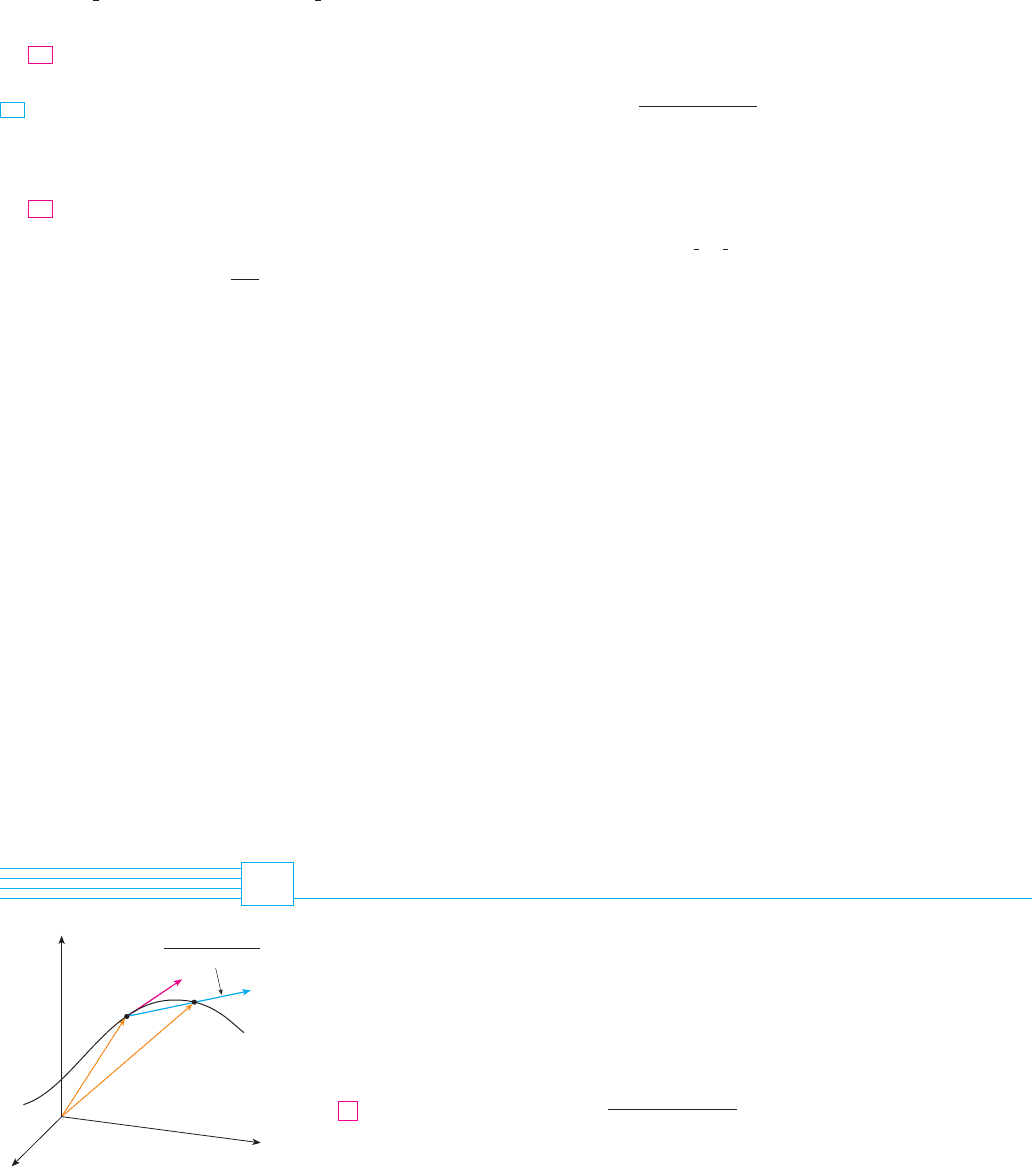
55. Use the Frenet-Serret formulas to prove each of the following.
(Primes denote derivatives with respect to . Start as in the
proof of Theorem 10.)
(a) (b)
(c)
(d)
56. Show that the circular helix ,
where and are positive constants, has constant curvature
and constant torsion. [Use the result of Exercise 55(d).]
57. Use the formula in Exercise 55(d) to find the torsion of the
curve .
58. Find the curvature and torsion of the curve ,
, at the point .
59. The DNA molecule has the shape of a double helix (see
Figure 3 on page 855). The radius of each helix is about
10 angstroms (1 ). Each helix rises about
during each complete turn, and there are about
complete turns. Estimate the length of each helix.
60. Let’s consider the problem of designing a railroad track to
make a smooth transition between sections of straight track.
Existing track along the negative -axis is to be joined
smoothly to a track along the line for .
(a) Find a polynomial of degree 5 such that the
function defined by
is continuous and has continuous slope and continuous
curvature.
;
(b) Use a graphing calculator or computer to draw the graph
of .F
F共x兲 苷
再
0
P共x兲
1
if x 0
if 0
x
1
if x 1
F
P 苷 P共x兲
x 1y 苷 1
x
2.9 10
8
34 ÅÅ 苷 10
8
cm
共0, 1, 0兲z 苷 ty 苷 cosh t
x 苷 sinh t
r共t兲 苷
具
t,
1
2
t
2
,
1
3
t
3
典
ba
r共t兲 苷 具a cos t, a sin t, bt典
苷
共rr兲 ⴢ r
ⱍ
rr
ⱍ
2
r 苷 关s
2
共s兲
3
兴
T 关3
ss
共s兲
2
兴
N
共s兲
3
B
rr 苷
共s兲
3
Br 苷 sT
共s兲
2
N
t
;
48. Find equations of the osculating circles of the parabola
at the points and . Graph both osculating
circles and the parabola on the same screen.
At what point on the curve , , is the
normal plane parallel to the plane ?
50. Is there a point on the curve in Exercise 49 where the
osculating plane is parallel to the plane ?
[Note: You will need a CAS for differentiating, for simplify-
ing, and for computing a cross product.]
Show that the curvature is related to the tangent and
normal vectors by the equation
52. Show that the curvature of a plane curve is ,
where is the angle between and ; that is, is the angle
of inclination of the tangent line. (This shows that the defini-
tion of curvature is consistent with the definition for plane
curves given in Exercise 69 in Section 11.2.)
53. (a) Show that is perpendicular to .
(b) Show that is perpendicular to .
(c) Deduce from parts (a) and (b) that for
some number called the torsion of the curve. (The
torsion measures the degree of twisting of a curve.)
(d) Show that for a plane curve the torsion is .
54. The following formulas, called the Frenet-Serret formulas,
are of fundamental importance in differential geometry:
1.
2.
3.
(Formula 1 comes from Exercise 51 and Formula 3 comes
from Exercise 53.) Use the fact that to deduce
Formula 2 from Formulas 1 and 3.
N 苷 B T
dB兾ds 苷
N
dN兾ds 苷
T
B
dT兾ds 苷
N
共s兲 苷 0
共s兲
dB兾ds 苷
共s兲N
Td B兾ds
Bd B兾ds
iT
苷
ⱍ
d
兾ds
ⱍ
dT
ds
苷
N
51.
x y z 苷 1
CAS
6x 6y 8z 苷 1
z 苷 t
4
y 苷 3tx 苷 t
3
49.
(
1,
1
2
)
共0, 0兲y 苷
1
2
x
2
874
||||
CHAPTER 14 VECTOR FUNCTIONS
MOTION IN SPACE: VELOCITY AND ACCELERATION
In this section we show how the ideas of tangent and normal vectors and curvature can be
used in physics to study the motion of an object, including its velocity and acceleration,
along a space curve. In particular, we follow in the footsteps of Newton by using these
methods to derive Kepler’s First Law of planetary motion.
Suppose a particle moves through space so that its position vector at time is .
Notice from Figure 1 that, for small values of , the vector
approximates the direction of the particle moving along the curve . Its magnitude mea-
sures the size of the displacement vector per unit time. The vector (1) gives the average
r共t兲
r共t h兲 r共t兲
h
1
h
r共t兲t
14.4
FIGURE 1
r(t+h)-r(t)
h
O
C
P
Q
rª(t)
r(t+h)
r(t)
x
z
y
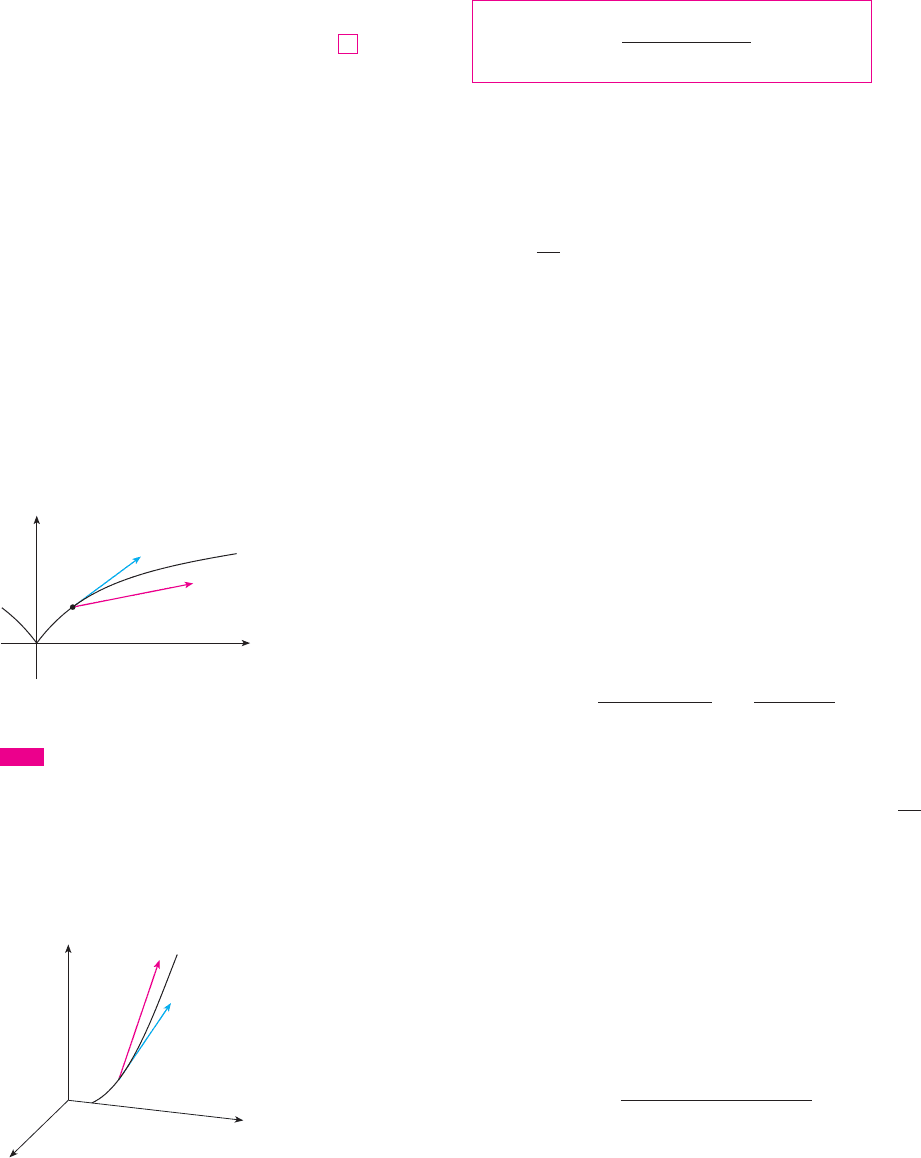
velocity over a time interval of length and its limit is the velocity vector at time :
Thus the velocity vector is also the tangent vector and points in the direction of the tangent
line.
The speed of the particle at time is the magnitude of the velocity vector, that is, .
This is appropriate because, from (2) and from Equation 14.3.7, we have
As in the case of one-dimensional motion, the acceleration of the particle is defined as the
derivative of the velocity:
EXAMPLE 1 The position vector of an object moving in a plane is given by
Find its velocity, speed, and acceleration when and illustrate
geometrically.
SOLUTION The velocity and acceleration at time are
and the speed is
When , we have
These velocity and acceleration vectors are shown in Figure 2. M
EXAMPLE 2 Find the velocity, acceleration, and speed of a particle with position vector
.
SOLUTION
M
The vector integrals that were introduced in Section 14.2 can be used to find position
vectors when velocity or acceleration vectors are known, as in the next example.
ⱍ
v共t兲
ⱍ
苷
s
4t
2
e
2t
共1 t兲
2
e
2t
a共t兲 苷 v共t兲 苷 具2, e
t
, 共2 t兲e
t
典
v共t兲 苷 r共t兲 苷 具2t, e
t
, 共1 t兲e
t
典
r共t兲 苷 具t
2
, e
t
, te
t
典
ⱍ
v共1兲
ⱍ
苷
s
13
a共1兲 苷 6 i 2 jv共1兲 苷 3 i 2 j
t 苷 1
ⱍ
v共t兲
ⱍ
苷
s
共3t
2
兲
2
共2t兲
2
苷
s
9t
4
4t
2
a共t兲 苷 r共t兲 苷 6t i 2 j
v共t兲 苷 r共t兲 苷 3t
2
i 2t j
t
t 苷 1r共t兲 苷 t
3
i t
2
j.
a共t兲 苷 v共t兲 苷 r共t兲
ⱍ
v共t兲
ⱍ
苷
ⱍ
r共t兲
ⱍ
苷
ds
dt
苷 rate of change of distance with respect to time
ⱍ
v共t兲
ⱍ
t
v共t兲 苷 lim
h l 0
r共t h兲 r共t兲
h
苷 r共t兲
2
tv共t兲h
SECTION 14.4 MOTION IN SPACE: VELOCITY AND ACCELERATION
||||
875
FIGURE 2
0
y
x
(1, 1)
a(1)
v(1)
Visual 14.4 shows animated velocity
and acceleration vectors for objects moving
along various curves.
TEC
N Figure 3 shows the path of the particle in
Example 2 with the velocity and acceleration
vectors when .t 苷 1
FIGURE 3
z
y
x
1
a(1)
v(1)
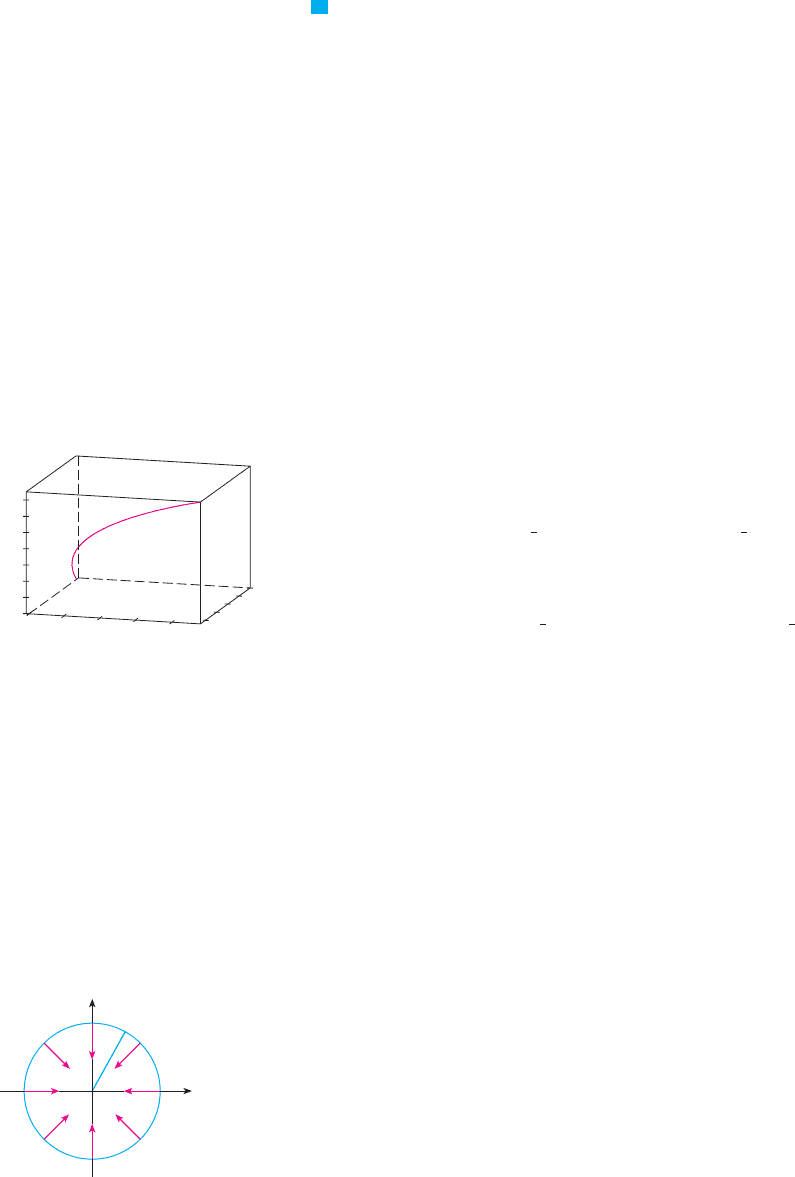
EXAMPLE 3 A moving particle starts at an initial position with initial
velocity . Its acceleration is . Find its velocity
and position at time .
SOLUTION Since , we have
To determine the value of the constant vector , we use the fact that .
The preceding equation gives , so and
Since , we have
Putting , we find that , so the position at time is given by
M
In general, vector integrals allow us to recover velocity when acceleration is known and
position when velocity is known:
If the force that acts on a particle is known, then the acceleration can be found from
Newton’s Second Law of Motion. The vector version of this law states that if, at any time
, a force acts on an object of mass producing an acceleration , then
EXAMPLE 4 An object with mass that moves in a circular path with constant angular
speed has position vector . Find the force acting on the
object and show that it is directed toward the origin.
SOLUTION To find the force, we first need to know the acceleration:
Therefore Newton’s Second Law gives the force as
F共t兲 苷 ma共t兲 苷 m
2
共a cos
t i a sin
t j兲
a共t兲 苷 v共t兲 苷 a
2
cos
t i a
2
sin
t j
v共t兲 苷 r共t兲 苷 a
sin
t i a
cos
t j
r共t兲 苷 a cos
t i a sin
t j
m
F共t兲 苷 ma共t兲
a共t兲mF共t兲t
r共t兲 苷 r共t
0
兲
y
t
t
0
v共u兲 duv共t兲 苷 v共t
0
兲
y
t
t
0
a共u兲 du
r共t兲 苷
(
2
3
t
3
t 1
)
i 共t
3
t兲
j
(
1
2
t
2
t
)
k
tD 苷 r共0兲 苷 it 苷 0
苷
(
2
3
t
3
t
)
i 共t
3
t兲
j
(
1
2
t
2
t
)
k D
苷
y
关共2t
2
1兲 i 共3t
2
1兲 j 共t 1兲 k兴 dt
r共t兲 苷
y
v共t兲 dt
v共t兲 苷 r共t兲
苷 共2t
2
1兲
i 共3t
2
1兲
j 共t 1兲
k
v共t兲 苷 2t
2
i 3t
2
j t k i j k
C 苷 i j kv共0兲 苷 C
v共0兲 苷 i j kC
苷 2t
2
i 3t
2
j t k C
v共t兲 苷
y
a共t兲 dt 苷
y
共4t i 6t j k兲 dt
a共t兲 苷 v共t兲
t
a共t兲 苷 4t i 6t j kv共0兲 苷 i j k
r共0兲 苷 具1, 0, 0典
V
876
||||
CHAPTER 14 VECTOR FUNCTIONS
N The expression for that we obtained in
Example 3 was used to plot the path of the
particle in Figure 4 for .0 t 3
r共t兲
FIGURE 4
(1,0,0)
0
20
x
0
20
y
0
4
z
6
2
5
10
15
N The angular speed of the object moving with
position is , where is the angle
shown in Figure 5.
苷 d
兾dtP
FIGURE 5
P
¨
0
y
x
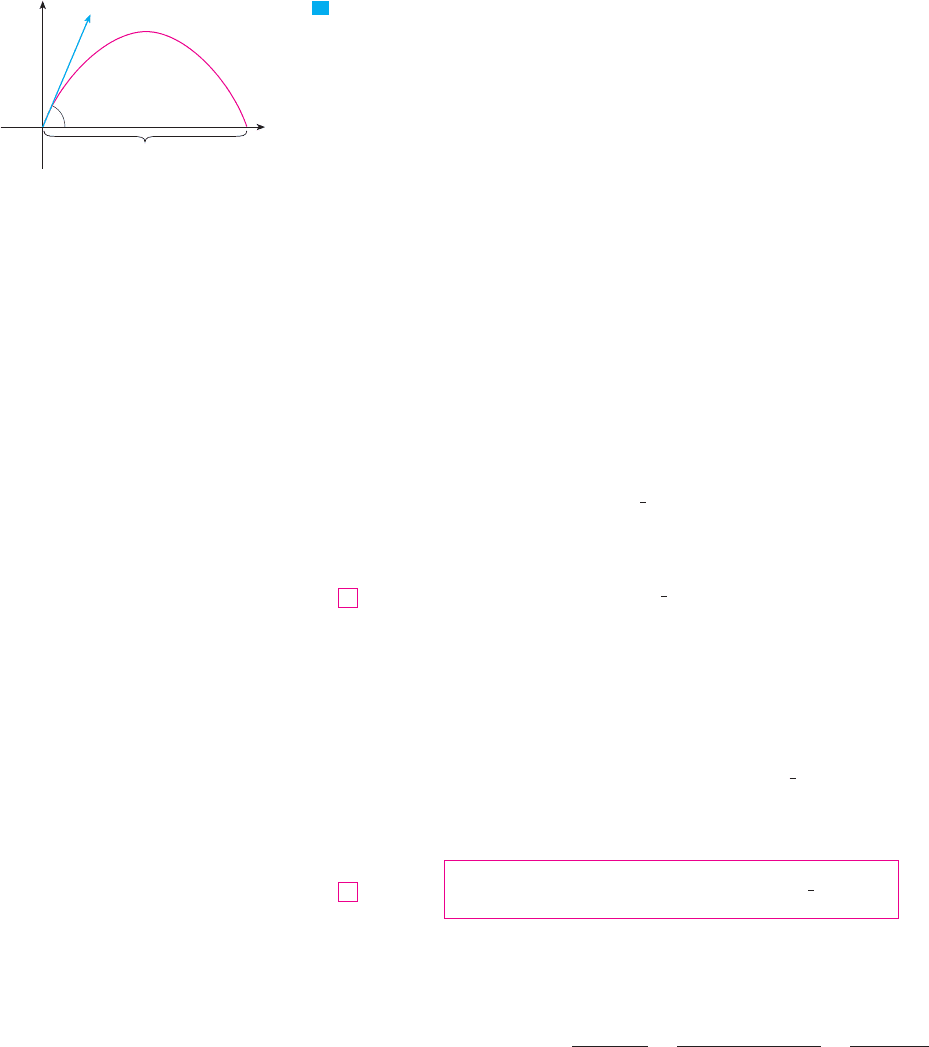
Notice that . This shows that the force acts in the direction opposite to
the radius vector and therefore points toward the origin (see Figure 5). Such a force
is called a centripetal (center-seeking) force. M
EXAMPLE 5 A projectile is fired with angle of elevation and initial velocity . (See
Figure 6.) Assuming that air resistance is negligible and the only external force is due to
gravity, find the position function of the projectile. What value of maximizes the
range (the horizontal distance traveled)?
SOLUTION We set up the axes so that the projectile starts at the origin. Since the force due
to gravity acts downward, we have
where m兾s . Thus
Since , we have
where . Therefore
Integrating again, we obtain
But , so the position vector of the projectile is given by
If we write (the initial speed of the projectile), then
and Equation 3 becomes
The parametric equations of the trajectory are therefore
The horizontal distance is the value of when . Setting , we obtain
or . This second value of then gives
Clearly, has its maximum value when , that is, . M
苷
兾4sin 2
苷 1d
d 苷 x 苷 共v
0
cos
兲
2v
0
sin
t
苷
v
2
0
共2 sin
cos
兲
t
苷
v
2
0
sin 2
t
tt 苷 共2v
0
sin
兲兾t
t 苷 0y 苷 0y 苷 0xd
y 苷 共v
0
sin
兲t
1
2
tt
2
x 苷 共v
0
cos
兲t
4
r共t兲 苷 共v
0
cos
兲t i
[
共v
0
sin
兲t
1
2
tt
2
]
j
v
0
苷 v
0
cos
i v
0
sin
j
ⱍ
v
0
ⱍ
苷 v
0
r共t兲 苷
1
2
tt
2
j t v
0
3
D 苷 r共0兲 苷 0
r共t兲 苷
1
2
tt
2
j t v
0
D
r共t兲 苷 v共t兲 苷 tt j v
0
C 苷 v共0兲 苷 v
0
v共t兲 苷 tt j C
v共t兲 苷 a
a 苷 t j
2
t 苷
ⱍ
a
ⱍ
⬇ 9.8
F 苷 ma 苷 mt j
r共t兲
v
0
V
r共t兲
F共t兲 苷 m
2
r共t兲
SECTION 14.4 MOTION IN SPACE: VELOCITY AND ACCELERATION
||||
877
FIGURE 6
0
y
x
a
d
v¸
N If you eliminate from Equations 4, you will
see that is a quadratic function of . So the
path of the projectile is part of a parabola.
xy
t

EXAMPLE 6 A projectile is fired with muzzle speed and angle of elevation
from a position 10 m above ground level. Where does the projectile hit the ground,
and with what speed?
SOLUTION If we place the origin at ground level, then the initial position of the projectile
is (0, 10) and so we need to adjust Equations 4 by adding 10 to the expression for .
With , , and , we have
Impact occurs when , that is, . Solving this quadratic
equation (and using only the positive value of ), we get
Then , so the projectile hits the ground about 2306 m away.
The velocity of the projectile is
So its speed at impact is
M
TANGENTIAL AND NORMAL COMPONENTS OF ACCELERATION
When we study the motion of a particle, it is often useful to resolve the acceleration into
two components, one in the direction of the tangent and the other in the direction of the
normal. If we write for the speed of the particle, then
and so
If we differentiate both sides of this equation with respect to , we get
If we use the expression for the curvature given by Equation 14.3.9, then we have
The unit normal vector was defined in the preceding section as , so (6) gives
and Equation 5 becomes
a 苷
vT
v
2
N
7
T 苷
ⱍ
T
ⱍ
N 苷
v N
N 苷 T兾
ⱍ
T
ⱍ
ⱍ
T
ⱍ
苷
vso
苷
ⱍ
T
ⱍ
ⱍ
r
ⱍ
苷
ⱍ
T
ⱍ
v
6
a 苷 v 苷 vT vT
5
t
v 苷
vT
T共t兲 苷
r共t兲
ⱍ
r共t兲
ⱍ
苷
v共t兲
ⱍ
v共t兲
ⱍ
苷
v
v
v
苷
ⱍ
v
ⱍ
ⱍ
v共21.74兲
ⱍ
苷
s
(
75
s
2
)
2
(
75
s
2
9.8 ⴢ 21.74
)
2
⬇ 151 m兾s
v共t兲 苷 r共t兲 苷 75
s
2
i
(
75
s
2
9.8t
)
j
x ⬇ 75
s
2
共21.74兲⬇2306
t 苷
75
s
2
s
11,250 196
9.8
⬇ 21.74
t
4.9t
2
75
s
2t 10 苷 0y 苷 0
y 苷 10 150 sin共
兾4兲t
1
2
共9.8兲t
2
苷 10 75
s
2
t 4.9t
2
x 苷 150 cos共
兾4兲t 苷 75
s
2
t
t 苷 9.8 m兾s
2
苷 45v
0
苷 150 m兾s
y
45
150 m兾s
V
878
||||
CHAPTER 14 VECTOR FUNCTIONS

Writing and for the tangential and normal components of acceleration, we have
where
This resolution is illustrated in Figure 7.
Let’s look at what Formula 7 says. The first thing to notice is that the binormal vector
B is absent. No matter how an object moves through space, its acceleration always lies in
the plane of T and N (the osculating plane). (Recall that T gives the direction of motion
and N points in the direction the curve is turning.) Next we notice that the tangential com-
ponent of acceleration is , the rate of change of speed, and the normal component of
acceleration is , the curvature times the square of the speed. This makes sense if we
think of a passenger in a car—a sharp turn in a road means a large value of the curvature
, so the component of the acceleration perpendicular to the motion is large and the pas-
senger is thrown against a car door. High speed around the turn has the same effect; in fact,
if you double your speed, is increased by a factor of 4.
Although we have expressions for the tangential and normal components of accelera-
tion in Equations 8, it’s desirable to have expressions that depend only on , , and . To
this end we take the dot product of with as given by Equation 7:
(since and )
Therefore
Using the formula for curvature given by Theorem 14.3.10, we have
EXAMPLE 7 A particle moves with position function . Find the tangen-
tial and normal components of acceleration.
SOLUTION
Therefore Equation 9 gives the tangential component as
a
T
苷
r共t兲 ⴢ r共t兲
ⱍ
r共t兲
ⱍ
苷
8t 18t
3
s
8t
2
9t
4
ⱍ
r共t兲
ⱍ
苷
s
8t
2
9t
4
r共t兲 苷 2i 2 j 6t k
r共t兲 苷 2t i 2t j 3t
2
k
r共t兲 苷 t
2
i t
2
j t
3
k
r共t兲 苷 具t
2
, t
2
, t
3
典
a
N
苷
v
2
苷
ⱍ
r共t兲 r 共t兲
ⱍ
ⱍ
r共t兲
ⱍ
3
ⱍ
r共t兲
ⱍ
2
苷
ⱍ
r共t兲 r 共t兲
ⱍ
ⱍ
r共t兲
ⱍ
10
a
T
苷 v 苷
v ⴢ a
v
苷
r共t兲 ⴢ r共t兲
ⱍ
r共t兲
ⱍ
9
T ⴢ N 苷 0T ⴢ T 苷 1 苷 vv
苷 vvT ⴢ T
v
3
T ⴢ N
v ⴢ a 苷 vT ⴢ 共vT
v
2
N兲
av 苷 vT
rrr
a
N
v
2
v
a
N
苷
v
2
anda
T
苷 v
8
a 苷 a
T
T a
N
N
a
N
a
T
SECTION 14.4 MOTION IN SPACE: VELOCITY AND ACCELERATION
||||
879
a
T
a
N
N
a
T
FIGURE 7

Since
Equation 10 gives the normal component as
M
KEPLER’S LAWS OF PLANETARY MOTION
We now describe one of the great accomplishments of calculus by showing how the mate-
rial of this chapter can be used to prove Kepler’s laws of planetary motion. After 20 years
of studying the astronomical observations of the Danish astronomer Tycho Brahe, the
German mathematician and astronomer Johannes Kepler (1571–1630) formulated the fol-
lowing three laws.
KEPLER’S LAWS
1. A planet revolves around the sun in an elliptical orbit with the sun at one
focus.
2. The line joining the sun to a planet sweeps out equal areas in equal times.
3. The square of the period of revolution of a planet is proportional to the cube of
the length of the major axis of its orbit.
In his book Principia Mathematica of 1687, Sir Isaac Newton was able to show that
these three laws are consequences of two of his own laws, the Second Law of Motion and
the Law of Universal Gravitation. In what follows we prove Kepler’s First Law. The
remaining laws are proved as exercises (with hints).
Since the gravitational force of the sun on a planet is so much larger than the forces
exerted by other celestial bodies, we can safely ignore all bodies in the universe except the
sun and one planet revolving about it. We use a coordinate system with the sun at the ori-
gin and we let be the position vector of the planet. (Equally well, could be the
position vector of the moon or a satellite moving around the earth or a comet moving
around a star.) The velocity vector is and the acceleration vector is . We use
the following laws of Newton:
where is the gravitational force on the planet, and are the masses of the planet and
the sun, is the gravitational constant, , and is the unit vector in the
direction of .
We first show that the planet moves in one plane. By equating the expressions for in
Newton’s two laws, we find that
a 苷
GM
r
3
r
F
r
u 苷 共1兾r兲rr 苷
ⱍ
r
ⱍ
G
MmF
Law of Gravitation: F 苷
GMm
r
3
r 苷
GMm
r
2
u
Second Law of Motion: F 苷 ma
a 苷 rv 苷 r
rr 苷 r共t兲
a
N
苷
ⱍ
r共t兲 r共t兲
ⱍ
ⱍ
r共t兲
ⱍ
苷
6
s
2
t
2
s
8t
2
9t
4
r共t兲 r共t兲 苷
ⱍ
i
2t
2
j
2t
2
k
3t
2
6t
ⱍ
苷 6t
2
i 6t
2
j
880
||||
CHAPTER 14 VECTOR FUNCTIONS
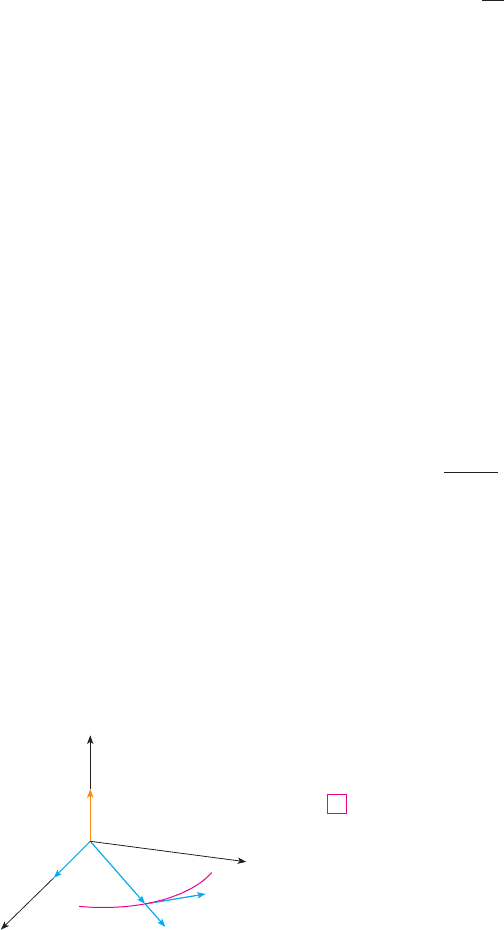
and so is parallel to . It follows that . We use Formula 5 in Theorem 14.2.3
to write
Therefore
where is a constant vector. (We may assume that ; that is, and are not parallel.)
This means that the vector is perpendicular to for all values of t, so the planet
always lies in the plane through the origin perpendicular to . Thus the orbit of the planet
is a plane curve.
To prove Kepler’s First Law we rewrite the vector as follows:
Then
(by Theorem 13.4.8, Property 6)
But and, since , it follows from Example 4 in Section 14.2 that
. Therefore
and so
Integrating both sides of this equation, we get
where is a constant vector.
At this point it is convenient to choose the coordinate axes so that the standard basis
vector points in the direction of the vector . Then the planet moves in the -plane.
Since both and are perpendicular to , Equation 11 shows that lies in the
-plane. This means that we can choose the - and -axes so that the vector lies in the
direction of , as shown in Figure 8.
If is the angle between and , then are polar coordinates of the planet. From
Equation 11 we have
苷 GMr u ⴢ u
ⱍ
r
ⱍⱍ
c
ⱍ
cos
苷 GMr rc cos
r ⴢ 共v h兲 苷 r ⴢ 共GM u c兲 苷 GM r ⴢ u r ⴢ c
共r,
兲rc
c
iyxxy
chuv h
xyhk
c
v h 苷 GM u c
11
共v h兲 苷 vh 苷 a h 苷 GM u
a h 苷 GM u
u ⴢ u 苷 0
ⱍ
u共t兲
ⱍ
苷 1u ⴢ u 苷
ⱍ
u
ⱍ
2
苷 1
苷 GM 关共u ⴢ u兲u 共u ⴢ u兲u兴
a h 苷
GM
r
2
u 共r
2
u u兲 苷 GM u 共u u兲
苷 r
2
共u u兲
苷 r u 共r uru兲 苷 r
2
共u u兲 rr共u u兲
h 苷 r v 苷 r r 苷 r u 共r u兲
h
h
hr 苷 r共t兲
vrh 苷 0h
r v 苷 h
苷 v v r a 苷 0 0 苷 0
d
dt
共r v兲 苷 rv r v
r a 苷 0ra
SECTION 14.4 MOTION IN SPACE: VELOCITY AND ACCELERATION
||||
881
FIGURE 8
y
z
x
u
v
r
c
h
¨
